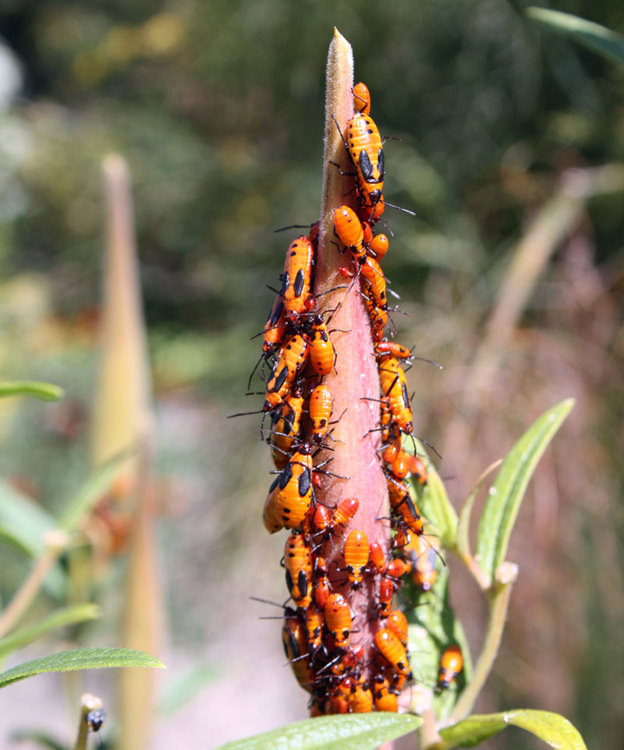
I spotted the first monarch butterfly caterpillar of the season last week! It was busy chomping away on my butterfly weed (Asclepias tuberosa), a plant I don’t usually find monarch caterpillars feasting on. They tend to prefer the other varieties of Asclepias in my garden. I’m not sure why this little guy (or girl) was on that particular variety of milkweed, but I wasn’t about to argue. I was just happy to see one!
It got me thinking about how milkweed is really a poster child for specialized insect feeding. You see, monarchs aren’t the only insect that is intimately tied to milkweed, using it as a food source and absorbing its toxic sap to become distasteful to predators. Several other insects can’t survive without this incredible plant.
Milkweed Bugs

Milkweed bugs (Oncopeltus fasciatus) are red-and-black true insects that use milkweed as their primary food source. They feed on the seeds held within the pods, rather than feeding on the foliage, as monarch caterpillars do. They hatch from eggs as tiny nymphs, then pass through five instars (or life phases), until they reach adulthood, shedding their skin several times as they grow. Each instar looks a little different, though they all have distinctive red-and-black coloration.
Milkweed bugs travel through this metamorphosis in about a month or so, staying attached to the seed pods during most of this time. They use a long, specialized mouth part to pierce through the pod and into the seeds. I often find dozens of them clustering on a seed pod.
Neither adults nor nymphs can bite or sting, so they’re no danger to humans. Just like monarch caterpillars, they have very few natural predators because the sap of milkweed plants is extremely unpalatable and toxic, and the insects take on this flavor as they feed.
The good news is that if you find milkweed bugs on your plants, know that they are not worth trying to control. Their feeding does not harm the overall health of the plant, though it might reduce the viability of the seeds.
Milkweed Beetles

Another milkweed-specific insect is the milkweed beetle (Tetraopes tetrophthalmus). This long-horned beetle’s only food source is milkweed, and it, too, takes on the toxins present in milkweed sap. As larvae, the milkweed beetle feeds on milkweed roots, but as it matures, it moves up the plant to feed on foliage and flower buds.
If you spot this super-cool insect on your milkweed plants, there’s no need to worry. The damage they cause is seldom significant enough to cause any harm. Adult beetles are about 3/4 inch long and have red-and-black coloration with long, black antennae. As a cool project, catch a milkweed beetle and hold it in your cupped hand. Raise your hand up to your ear and have a listen. Adult beetles purr and squeak. If you’re squeamish about holding one, put it into a jar instead and lower your ear to the opening to hear the beetle “talk.” It’s really amazing.
Make room in your own garden for as many milkweed species as you can and you’ll not only be helping the monarchs, but also all the other amazing insects that co-evolved with this fascinating plant.




